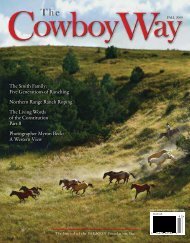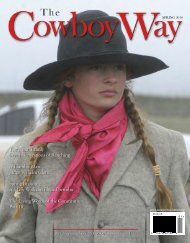Fifty Miles from Home Fifty Miles from Home - Paragon Foundation
Fifty Miles from Home Fifty Miles from Home - Paragon Foundation
Fifty Miles from Home Fifty Miles from Home - Paragon Foundation
You also want an ePaper? Increase the reach of your titles
YUMPU automatically turns print PDFs into web optimized ePapers that Google loves.
42<br />
the disappointment of the crowd, however, the chief<br />
executive declined to try it on then but offered to model it<br />
later at the White House. Felled by an assassin’s bullet a few<br />
hours later in Dallas, JFK never got the chance to make<br />
good on his promise.<br />
lyndon Johnson’s association with the cowboy image<br />
was well established before he settled into the presidential<br />
saddle. outfitted in Western wear and relaxing at his ranch,<br />
the rangy Texan both looked and played the part of a<br />
Westerner. He enjoyed showing off the 2,700-acre spread to<br />
visitors and often could be seen touring u.S. government<br />
officials and foreign heads of state around the property. as<br />
vice president, his ranch guests had included Field marshal<br />
mohammed ayub Khan of Pakistan and West German<br />
Chancellor Konrad adenauer. In December 1963, only a<br />
month after the Kennedy assassination, he invited ludwig<br />
erhard, the new leader of West Germany, to the lBJ Ranch.<br />
The following spring he extended the same honor to<br />
President Gustavo Diaz ordaz of mexico. The president’s<br />
special guests nearly always left the Texas White House with<br />
both a better understanding of its occupant and a cowboy<br />
hat, bestowed with great ceremony by their host. one<br />
reporter dubbed lBJ’s informal ranch meetings with foreign<br />
heads of state “barbecue diplomacy.”<br />
The 1964 election pitted Johnson against Senator Barry<br />
Goldwater of arizona, another politician who identified<br />
strongly with cowboy tradition. although both candidates<br />
invoked their cowboy credentials<br />
during the campaign, journalists and<br />
cartoonists tended to portray the<br />
bellicose Goldwater as a trigger-happy,<br />
black-hatted villain armed with nuclear<br />
missiles in his pistol holsters.<br />
Johnson won reelection by a<br />
landslide, and, in high spirits, hosted a<br />
barbecue at the Texas White House for<br />
his staff and the press soon after.<br />
During the festivities, the president and<br />
his running mate, Hubert Humphrey<br />
of minnesota, appeared on horseback<br />
dressed as ranchers, to the delight of<br />
photographers who spread the image<br />
around the world.<br />
although comfortable portraying<br />
the traditional cowboy hero on his own<br />
range, Johnson was keenly aware that<br />
the image did not play well in some quarters. according to<br />
one presidential staffer, the president-elect urged Texans<br />
bound for his inaugural to leave their boots and hats at<br />
home and not to ride into Washington like a bunch of wild<br />
cowboys on a spree.<br />
For a world worried about a nuclear holocaust, the image of<br />
a missile-toting u.S. presi dent facing off against his Soviet<br />
w w w. pa r a g o n f o u n d at i o n .o r g<br />
counterpart in a Hollywood-style Western showdown<br />
proved even more troublesome. one West German reporter<br />
wondered if “‘the cowboy <strong>from</strong> Texas’ believed in ‘lynch law’<br />
or ‘international law.’”<br />
French President Charles de Gaulle, Johnson’s perhaps<br />
most vocal foreign critic, considered the american president<br />
crude and provincial, with little appreciation of the world at<br />
large. “Johnson, he’s a cowboy, and that’s saying everything,”<br />
he said, “the very portrait of america. He reveals the<br />
country to us as it is, rough and raw. If he didn’t exist, we’d<br />
have to invent him.”<br />
With the escalation of the Vietnam War in 1965, the<br />
president increasingly came under attack in political<br />
cartoons and anti-war posters as a reckless and overbearing<br />
cowboy. Three years later, haggard and saddle worn, lyndon<br />
Johnson hung up his political spurs and retired to his Texas<br />
ranch. although it seemed with Johnson’s retirement that<br />
the cowboy image had been put out to pasture once and for<br />
all, its absence <strong>from</strong> the oval office was short-lived.<br />
Republican Richard Nixon, who replaced Johnson as<br />
president, was an inveterate fan of motion pictures. He was<br />
especially fond of Western films directed by John Ford and<br />
starring John Wayne, whose cinematic portrayals of the<br />
cowboy set the modern standard for the genre. Wayne was<br />
also active in politics and had openly supported Nixon’s bid<br />
for the White House. In 1970, the Wayne Western Chisum<br />
struck a special chord with the president, who referred to<br />
richard M. nixon<br />
the cowboy justice meted out in the film’s plot to help<br />
explain his own views on law and order to reporters at a<br />
press conference.<br />
In 1974, the cowboy of popular culture made another<br />
unexpected appearance, this time on air Force one carrying<br />
President Nixon and Soviet Premier leonid Brezhnev to a<br />
summit conference in California. Flying over the Grand




